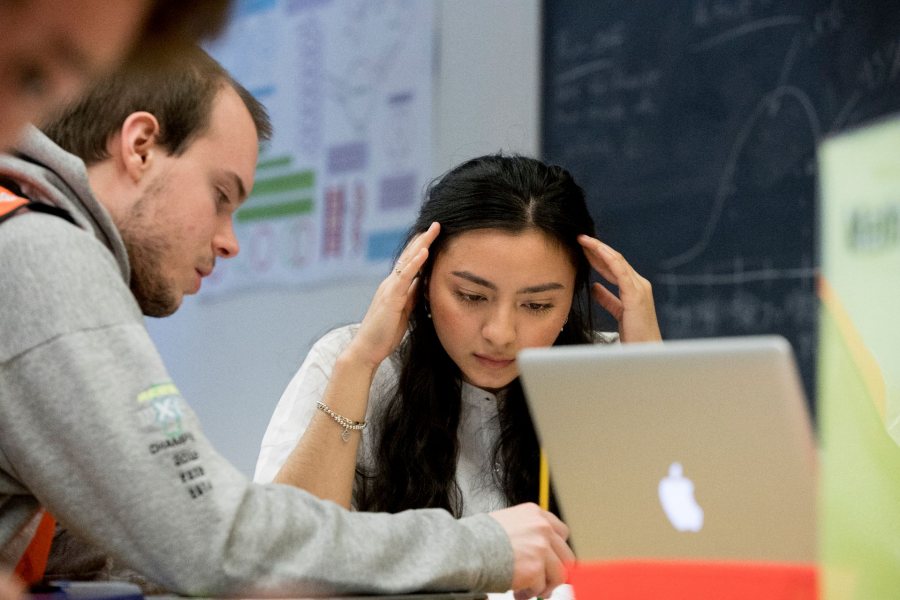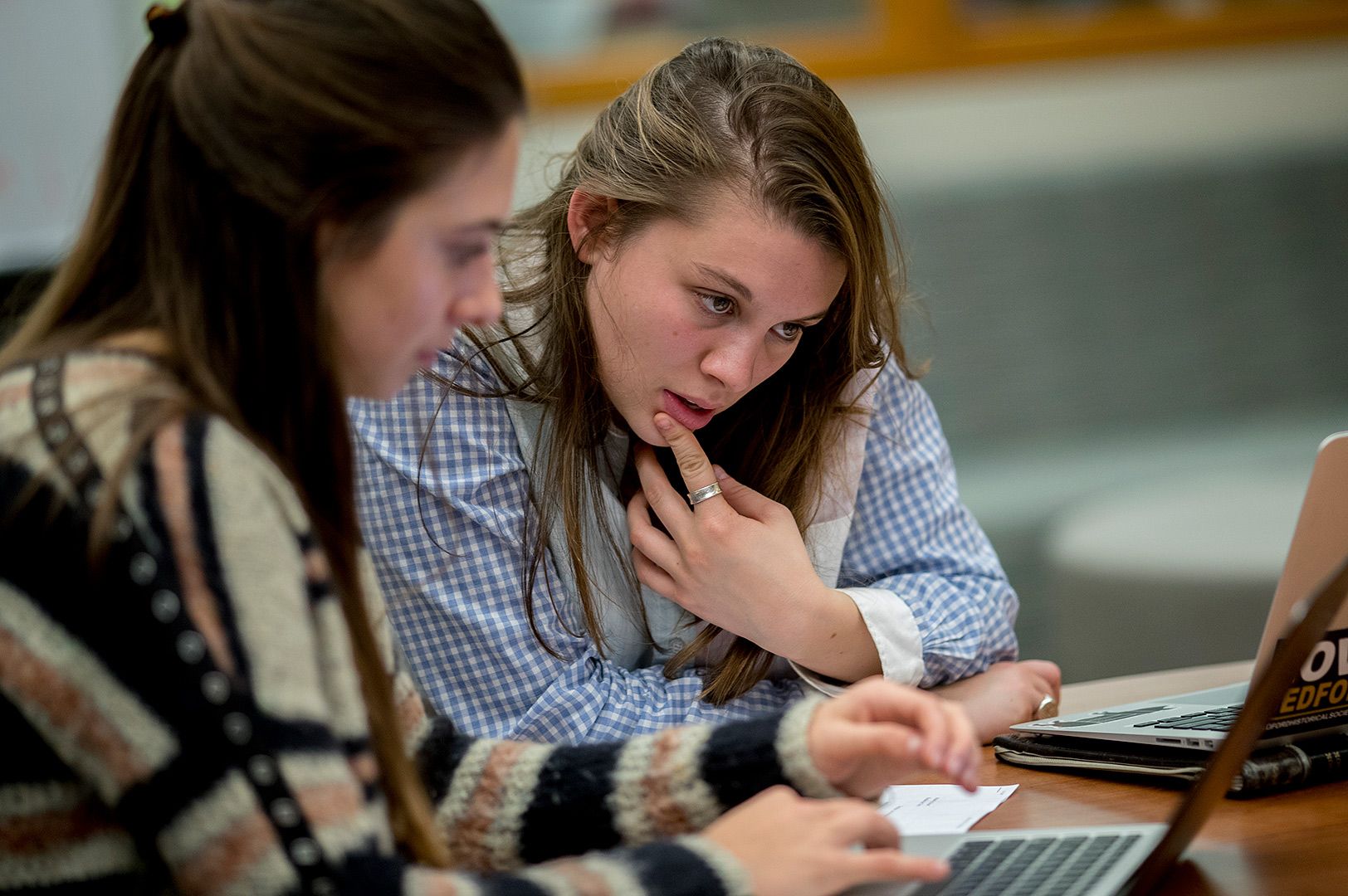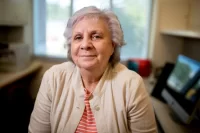
The people involved in Bates’ peer-tutoring program know how good it is — and now the word’s about to spread, thanks to recognition from the national organization that sets standards for training peer tutors.
Now in its third year, the system for training Bates’ excellent peer tutors received the International Tutor Training Program Certification from the College Reading and Learning Association on Jan. 7.
The certification “says that we’re serious about our work,” says Dan Sanford, who oversees tutor training as the director of the college’s Academic Resource Commons. “It says that we’re serious about making sure that every Bates student, from first-year student to graduating senior, is supported throughout that entire process.”
“There’s a well-recognized set of best practices nationally for learning centers” like the ARC, Sanford explains. The CRLA certification, which requires a long and rigorous evaluation process, tells the world that a given program meets those criteria.

Math tutor Gabe Nelson ’20 of South Burlington, Vt., works with Monica Luna ’21 of Avondale, Ariz., in the Mathematics and Statistics Workshop in Ladd Library. (Phyllis Graber Jensen/Bates College)
“It’s a mark of maturity and of national recognition for ARC, and a nice feather in Bates’ cap,” Sanford says, especially because CRLA “looks comprehensively at a learning center’s entire institutional context in awarding these certifications.”
He adds that the ITTPC makes Bates unique among the NESCAC schools. And if the certification is a valuable credential for Bates and the ARC, it can be a powerful resume item for the peer tutors as well, especially those planning a career in education or hoping to land teaching assistantships in graduate school.
Around 100 students serve as peer tutors, filling a variety of roles in ARC headquarters in Ladd Library. There are peer tutors in specific disciplines; tutors in writing and speaking; experts in the academic resources available to students; and peer-assisted learning leaders who, as veterans of an especially challenging course, can tutor students who come after them in that course.

The Bates training, Sanford notes, was designed around the CRLA criteria (which, in outline form, fill 10 pages). Training begins with a half-day session just before classes start in September and continues throughout the academic year.
Though it encompasses topics as diverse as Title IX guidelines and the cognitive science behind adult learning, the core of the training involves collaborative learning and active learning (which uses various techniques to effect active student engagement with what’s being taught).
In essence, empowerment is the objective of this training. And empowering the tutee may require some impulse adjustment for the tutor. “Students become tutors because they know their stuff,” says Sanford. “When you’re tutoring, the most natural thing to do is open your mouth and let all of the things you know come out.”

Dan Sanford is the director of Bates’ Academic Resource Commons and the Writing at Bates program. (Josh Kuckens/Bates College)
But, he continues, “a lot of tutor training goes to checking that instinct.” The point is to “encourage the student who comes in for tutoring to do as much talking as the tutor, and to empower the expertise and knowledge of the tutee.”
Sarah Raphael ’21 of Carlisle, Pa., is a student manager in ARC and a peer writing and speaking assistant for a first-year seminar. She sees tutoring as “a bridge between teaching and learning.
“Professors at Bates don’t want students to regurgitate material, but rather to think critically about content. Tutors endeavor to guide the transition between the presentation of information and the comprehension of information.”
Advancing equity is another key concept in the training, focusing on the specific abilities of students from various linguistic, racial, and ethnic groups, as well as those of first-generation-to-college students.
The point is to empower the expertise and knowledge of the tutee.
And there’s also an important counseling component. “Students may be stressed out, overwhelmed by their studies,” Sanford notes. “There’s an emotional component of being listened to, and calming down a little bit, that has to happen before students can get in a place where they can learn.”
Bates’ peer-tutor training is unique in at least one aspect that Sanford has been able to discern: Tutors are required to write reflections on the trainings as they progress through the program, he explains. “Those reflections become, over time, a portfolio of their progress through the training curriculum.
“And then they develop, as another part of that portfolio, a statement of their own philosophy as a peer educator that builds on all those reflections.” The capper is producing a project for ARC “that’s rooted in that philosophy and that pulls all those reflections together.
“They create trainings, they create posters, they create study guides — there are a lot of directions they can go in.” So a chemistry tutor deeply dedicated to active learning might, for example, create a set of pedagogical tools that chemistry students can use in ARC.
The certification arrives at an auspicious time. ARC was established as a pilot program — an experiment, as Sanford says — supported by a Davis Educational Foundation grant. Bringing peer-tutor training at Bates up to contemporary national standards, including support for the full spectrum of student needs, was an objective of that experiment.
“What we really did is put together sort of an outline, a sketch, of a learning center. And the students who run the center filled that out and made ARC what it is,” Sanford explains.
The Davis grant runs out in June and ARC, having proved its worth, will transition from pilot program to established institutional asset — “a permanent part of the Bates vision,” Sanford says. “And it’s because of what the students have brought to it in coloring in that sketch.”

In this 2017 image taken in the Academic Resource Commons, Claudia Krasnow ’18 (at right), peer writing and speaking assistant for a Spanish course, works with Madelyn Heart ’18 on a paper. (Phyllis Graber Jensen/Bates College)



